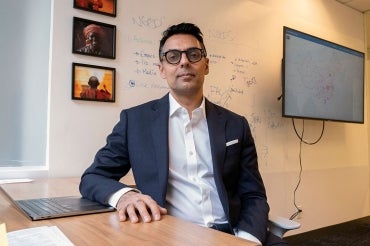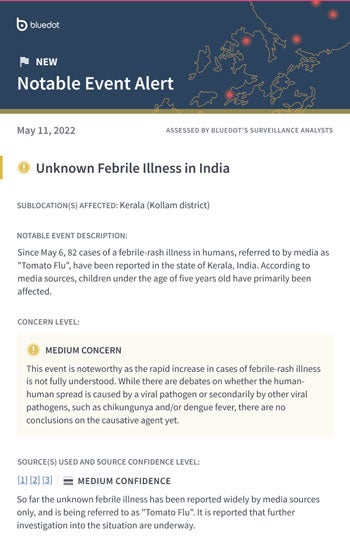BlueDot is using AI to get ahead of the next pandemic

Kamran Khan, founder and CEO of BlueDot, is a scientist at Unity Health Toronto and a professor in the department of medicine in the University of Toronto’s Temerty Faculty of Medicine and the Dalla Lana School of Public Health (photo by JORGE UZON/AFP via Getty Images)
Published: August 15, 2023
The Toronto offices for Kamran Khan’s BlueDot, which uses artificial intelligence to flag potential infectious disease outbreaks around the world, are located at the edge of Lake Ontario – appropriate for a company that, similar to a lighthouse, signals when there’s danger ahead.
“We use the internet as a medium for surveillance to detect early signals of outbreaks anywhere in the world before they’re officially reported by public health agencies,” explains Khan, a scientist at Unity Health Toronto and a professor in the department of medicine in the University of Toronto’s Temerty Faculty of Medicine and the Dalla Lana School of Public Health.
He breaks BlueDot’s work down into three key components: identifying threats early, rapidly assessing their risks and likely trajectories, and helping organizations to turn these insights into swift action.
“The whole purpose here is to compress time, because ultimately, time is the enemy when you’re dealing with an outbreak,” says Khan, a member of U of T’s Centre for Vaccine Preventable Diseases.
BlueDot’s intelligence platform combines a computer’s ability to understand human language, known as natural language understanding (NLU), and machine learning, a form of AI that imitates humans’ ability to learn and gradually become more accurate. The platform sorts through massive volumes of online information – ranging from news reports, social media sites, government websites, and more – from around the globe, in more than 130 languages, every 15 minutes of every day.
“We’ve basically trained a machine to pick up early clues around the world and around the clock,” explains Khan.
The clues get cross-referenced with historic data to determine what is outside of the norm, and then triaged into high, medium and low risk threats. Global data – including commercial air travel data, climate conditions, mosquito observances and population demographics – are also added to the mix to determine whether a threat could spread.
This data analytic sequence is how BlueDot accurately predicted a Zika virus outbreak in Florida six months before it occurred, and sounded the alarm about COVID-19 nearly a week before it was officially reported by public health organizations like the CDC and WHO.
As COVID-19 restrictions have eased around the world, public health experts are now shifting focus to the next set of emerging global threats – what could spark the next pandemic, and will we be ready? Writer Ishani Nath sat down with Khan to learn how BlueDot uses artificial and human intelligence to help answer these questions and more.
How does BlueDot work – is it all done by machines or do humans play a role?
Our belief is that machines should play to their strengths, and humans should play to their own. There’s a whole process of using machine learning for gathering, organizing and ingesting unstructured data that’s multilingual and creating structure out of it 24 hours a day, 365 days a year. And then there’s a series of analytics and human intelligence that helps us differentiate what threats demand our immediate attention and anticipate where, when, and how they will impact the health of populations around the globe. Recent advances in generative AI are also creating opportunities for machines to produce “intelligence briefs” – but given the vital importance of these outputs, there will always be a need for human oversight.
For example, we first have to determine whether a threat appearing somewhere in the world is unusual. It’s important to remember that machine learning is only as good as the historic data that we train it on. But when we’re dealing with newly emerging diseases, we are often dealing with threats where there is little or no historic data. For instance, if we identify an outbreak of an influenza-like illness occurring in the Northern Hemisphere in July, we know that is unusual compared with observed historic trends. But for some newly emerging threats like COVID-19 – where we don’t have historic data – we have to tap into our in-house expertise in public health sciences, clinical medicine, pediatric infectious disease and veterinary sciences, while also collaborating with experts from academia and governments around the world to rapidly characterize and assess those novel threats.

When it comes to vaccines, how can this information improve which threats get addressed?
Well, we’re not just considering what constitutes a vaccine-preventable disease today. By working with private sector organizations like pharmaceutical companies, we’re helping support decisions about what they should be investing in in terms of R&D to develop new vaccines for diseases where the landscape is going to significantly change in the future – for example, because of climate change.
And when vaccines are in market, are they manufacturing enough in relation to forthcoming demand? Are they producing it at the right time? Are they distributing it optimally and equitably? BlueDot’s public and private sector clients are using our intelligence to support key decisions – not just about what’s happening now, but also what’s coming next.
You mentioned climate change. Do you also consider climate and environmental data?
Yes. Going back to Zika for example – what we were able to determine and publish in the Lancet is where we would expect lots of infected travellers and no local outbreak versus lots of infected travellers, as well as environmental conditions suitable for a local outbreak. What happened six months later is entirely aligned with what we anticipated.
We’re now working on taking the latest climate change models and intersecting them with ecological models for mosquitoes and insects so we can anticipate where those insects will survive and thrive in new areas. If you don’t have the mosquito that can transmit a particular virus, then there’s no possibility of a local outbreak from that virus. But these ranges are changing. In some cases, it’s actually becoming too hot and they’re not able to effectively transmit. But in other cases, conditions are becoming more hospitable.
How far into the future do these forecasts extend?
We’re doing these forecasts looking 10 years into the future. The main reason we’re looking out that far, realizing there’s more uncertainty as you go further out, is that we are working with pharmaceutical and life sciences companies that develop and manufacture vaccines, therapeutics, diagnostics, PPE, disinfectants and more. Their interests are understanding and anticipating future demand. Do they invest in a chikungunya vaccine or a vaccine for a different infectious disease? A vaccine manufacturer has to consider: What am I investing in today, how many lives could it protect and is this a sound business decision recognizing that it might take a decade or more to actually bring that vaccine to market?
What’s next for BlueDot?
Building on top of large language models (LLMs) like GPT, we’ve developed some early capabilities where you can ask our platform questions in natural language. Like, “Every day, tell me how many cases of COVID there are in my location this week and if there’s an increase of 10 per cent or more above baseline, notify me.” Or, “Tell me how many travellers on flights are coming from London to Toronto in the next three months and the likelihood of an imported case of measles showing up.” We’re still actively in R&D mode but building on top of LLMs is showing a lot of promise.
How does working in this space shape how you personally feel about the future?
I’m excited by the fact that technology can help humans in powerful ways, but understand that humans have to help themselves. I often quote the Spanish-American philosopher George Santayana who said, “Those who cannot remember the past are condemned to repeat it.” My worry is we’re quick to forget and that we will repeat the cycle of panic followed by neglect until humanity realizes we have to be proactive – because we know it’s a certainty we will be dealing with more threats in the future. What I often ask myself is, what things can I do today that will have a tangible and positive impact on the lives of others?
This interview has been edited and condensed for clarity.
Read more about BlueDot at CTV News



